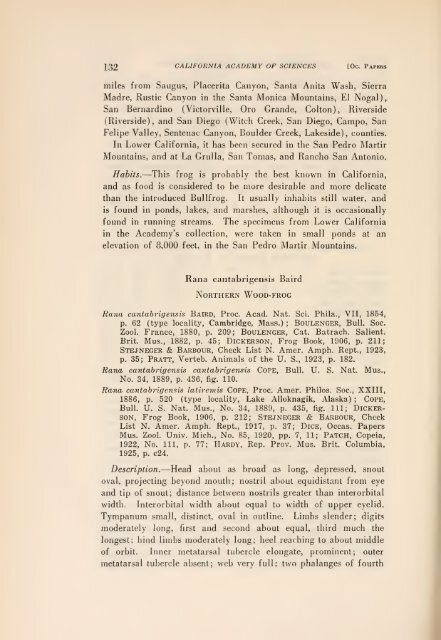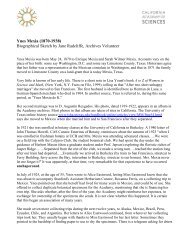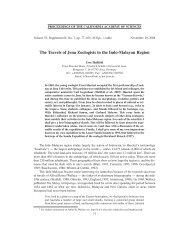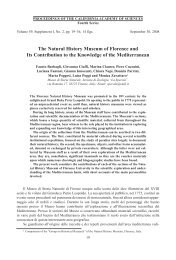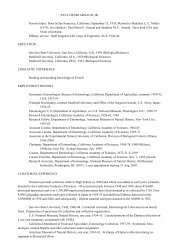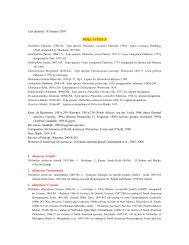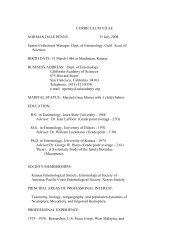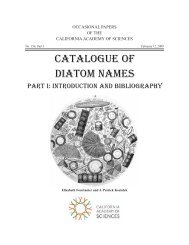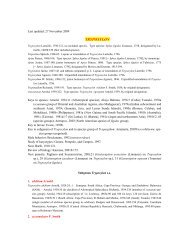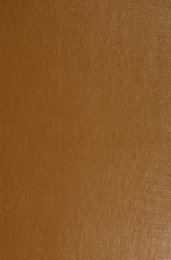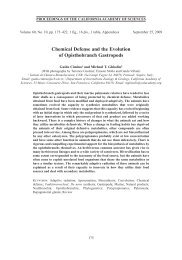PDF (9.91 MB) - Academy Research - California Academy of Sciences
PDF (9.91 MB) - Academy Research - California Academy of Sciences
PDF (9.91 MB) - Academy Research - California Academy of Sciences
Create successful ePaper yourself
Turn your PDF publications into a flip-book with our unique Google optimized e-Paper software.
132 CALIFORNIA ACADEMY OF SCIENCES [Oc Papers<br />
miles from Saugus, Placenta Canyon, Santa Anita Wash, Sierra<br />
Madre, Rustic Canyon in the Santa Monica Mountains, El Nogal),<br />
San Bernardino (Victorville, Oro Grande, Colton), Riverside<br />
(Riverside), and San Diego (Witch Creek, San Diego, Campo, San<br />
Felipe Valley, Sentenac Canyon, Boulder Creek, Lakeside), counties.<br />
In Lower <strong>California</strong>, it has been secured in the San Pedro Martir<br />
Mountains, and at La Grulla, San Tomas, and Rancho San Antonio.<br />
Habits.— This frog is<br />
probably the best known in <strong>California</strong>,<br />
and as food is considered to be more desirable and more delicate<br />
than the introduced Bullfrog. It usually inhabits still water, and<br />
is found in ponds, lakes, and marshes, although<br />
it is occasionally<br />
found in running streams. The specimens from Lower <strong>California</strong><br />
in the <strong>Academy</strong>'s collection, were taken in small ponds at an<br />
elevation <strong>of</strong> 8,000 feet, in the San Pedro Martir Mountains.<br />
Rana cantabrigensis Baird<br />
Northern Wood-frog<br />
Rana cantabrigensis Baird, Proc. Acad. Nat. Sci. Phila., VII, 1854,<br />
p. 62 (type locality, Cambridge, Mass.) ; Boulenger, Bull. Soc.<br />
Zool. France, 1880, p. 209; Boulenger, Cat. Batrach. Salient.<br />
Brit. Mus., 1882, p. 45; Dickerson, Frog Book, 1906, p. 211;<br />
Stejneger & Barbour, Check List N. Amer. Amph. Rept., 1923,<br />
p. 35; Pratt, Verteb. Animals <strong>of</strong> the U. S., 1923, p. 182.<br />
Rana cantabr-igensis cantabrigensis Cope, Bull. U. S. Nat. Mus.,<br />
No. 34, 1889, p. 436, fig. 110.<br />
Rana cantabrigen'^is latij-e^nis CoPE, Proc. Amer. Philos. Soc, XXIII,<br />
1886, p. 520 (type locality. Lake Alloknagik, Alaska) ; Cope,<br />
Bull. U. S. Nat. Mus., No. 34, 1889, p. 435, fig. Ill; Dickerson,<br />
Frog Book, 1906, p. 212; Stejneger & Barbour, Check<br />
List N. Amer. Amph. Rept., 1917, p. 37; Dice, Occas. Papers<br />
Mus. Zool. Univ. Mich., No. 85, 1920, pp. 7, 11; Patch, Copeia,<br />
1922, No. Ill, p. 77; Hardy, Rep. Prov. Mus. Brit. Columbia,<br />
1925, p. c24.<br />
Description. — Head about as broad as long, depressed, snout<br />
oval, projecting beyond mouth; nostril about equidistant from eye<br />
and tip <strong>of</strong> snout; distance between nostrils greater than interorbital<br />
width. Interorbital width about equal to width <strong>of</strong> upper eyelid.<br />
Tympanum small, distinct, oval in outline. Limbs slender; digits<br />
third much the<br />
moderately long, first and second about equal,<br />
longest; hind limbs moderately long; heel reaching to about middle<br />
<strong>of</strong> orbit. Inner metatarsal tubercle elongate, prominent; outer<br />
metatarsal tubercle absent; web very full; two phalanges <strong>of</strong> fourth


